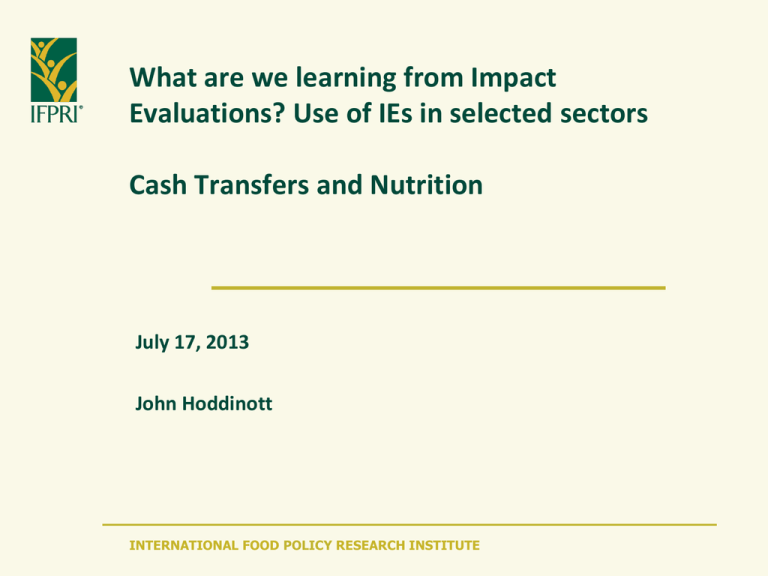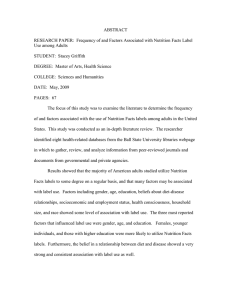What are we learning from Impact Cash Transfers and Nutrition
advertisement

What are we learning from Impact Evaluations? Use of IEs in selected sectors Cash Transfers and Nutrition July 17, 2013 John Hoddinott INTERNATIONAL FOOD POLICY RESEARCH INSTITUTE Prologue : An email thread Dear John, We're putting together a one-day event on July 17th - joint CGD and 3ie - to look at how the Impact evaluation field has evolved and what's needed to improve it heading forward. Howard and I would like to invite you to make a presentation on your views regarding what we’ve learned from impact evaluations in agriculture policy, how you see the recent ‘crop’ of studies making a difference and what you think the sector needs in terms of future learning. Best regards, Bill Prologue : An email thread Bill, Thanks for this message. I would be pleased to participate. However, I know nothing about impact evaluations in agriculture policy. I could say something about nutrition, CCTS or CCTs and nutrition. Would that help? John Prologue : An email thread Hi John, Yes, of course. Nutrition would be the right topic and if you would like to link in the work on CCTs and nutrition that would be fine. Since this is part of a broader discussion about the future of impact evaluations, it would be great if you could both describe what we’ve learned from impact evaluations in this field over recent years and what you think is required to have useful knowledge in the future. Yours, bill Part 1: What do we know about nutrition and (C)CTs Studies have been undertaken using (mostly) randomized designs in Brazil, Colombia, Ecuador, Honduras, Mexico, Nicaragua, Peru Non-experimental results from Bangladesh and South Africa A striking feature of this literature is the large number of literature reviews and summary studies. A partial list: Lagarde M. et al (2008). JAMA Fiszbein A, Schady N (2009) Conditional cash transfers for attacking present and future poverty Leroy JL, et al (2009) J Deve Effect Adato M, Hoddinott J. (2010) Conditional cash transfers in Latin America Manley J, et al (2012) How effective are cash transfer programmes at improving nutritional status? A rapid evidence assessment of programmes’ effects on anthropometric outcomes DFID. (2011) Cash transfer evidence paper. Ruel, MT and Alderman, H. (2013) The Lancet Part 1: What do we know about nutrition and (C)CTs Analysis of data from Mexico (PROGRESA/Oportunidades): • Most, but not all, studies show strong positive impacts on height and some of the positive results are not replicable • Not clear that impacts persist Other studies show small or no effects on height or on micronutrient (anemia) status Programs differ so much, and there is so much variation in implementation (eg size of transfer, duration and frequency of transfers, strength of conditions, pre-existing levels of undernutrition, health services), that it is difficult to support a strong view on the impact of (C)CTs on nutrition. Conclusions of summary studies range from cautiously optimistic (Ruel and Alderman, 2013) to the pessimistic (Manley et al, 2012, meta-analysis shows insignificant results ) Part 2: A tale of two experiments EXPERIMENT 1 An experiment (though not an impact evaluation) Modest amount of pretesting 240 subjects in six nonrandomly selected localities. Study is cross-sectional WILDLY INFLUENTIAL in its field with more than 3,000 citations EXPERIMENT 2 An impact evaluation Experiment was preceded by five years of preparatory fieldwork and smaller studies 26,000 subjects randomly assigned to treatment and control across 450 villages. Study has pre-intervention and post-intervention surveys with minimal attrition Approximately 650 citations Part 2: A tale of two experiments Experiment (1) is the Binswanger experiments (late 1970s, 1980s) used to elicit measures of risk aversion in six semi-arid Indian villages For the next 20 years, nearly all discussions in development economics of risk aversion among farmers in rural countries are based on the Binswanger results Experiment (2) is the work by Alfred Sommer in Indonesia (mid 1980s) on the impact of Vitamin A deficiency on infant and child mortality 25 years later, Bhutta et al (2013) summarize evidence from 43 RCTs, nearly all done after the Sommer study, on Vitamin A deficiency and infant and child mortality Part 3: Learning in nutrition and learning from nutritionists for knowledge and influence Part 1 tells us: • Economists have started to use more robust evaluation techniques to look at the impact of CCTs on nutrition outcomes (a strength) • There has been considerable effort to summarize the findings of these studies - Savedoff (a strength and a weakness) Part 2 tells us: • Economists, relative to nutritionists, can be easily satisfied. One study is “enough” How then do nutritionists “learn” from impact evaluations and what can economists learn from them 9 Part 3: Learning in nutrition and learning from nutritionists for knowledge and influence Value of formative research – both qualitative and quantitative – and small scale pilot studies (Rozelle: causal chain analysis) Careful attention to power calculations especially when evaluation aims to examine multiple impacts (eg Nicaragua study which ‘nearly’ shows impact of CCT on nutritional status was likely underpowered) Understanding and learning from program implementation (Birdsall, Savedoff: process evaluation) • Useful information for policy makers and implementers (Duryea). (Economists ascribe no academic value to such studies) • Being clear on how implementation, compliance and take-up affect results (eg Nicaragua RPS and anemia) 10 Part 3: Learning in nutrition and learning from nutritionists for knowledge and influence Efficacy and effectiveness trials • Efficacy: Does it work under ideal conditions • Effectiveness/Upscaling: Does it work under ‘ordinary’ conditions Multiple treatment arms to unpack role played by components within an intervention • Badly needed for work on CCTs and nutrition Replication, replication, replication (1) – do researchers document their work sufficiently well so that other researchers can replicate results Replication, replication, replication (2) – “identical” interventions evaluated in different places Looking to the longterm (Rozelle) – INCAP longitudinal study 11



